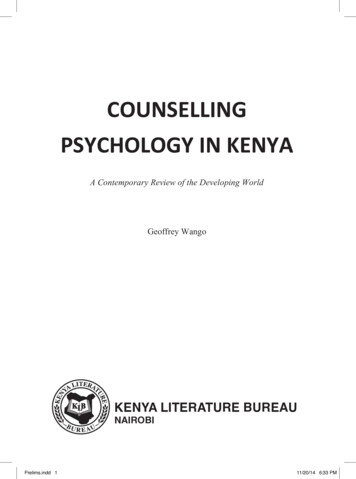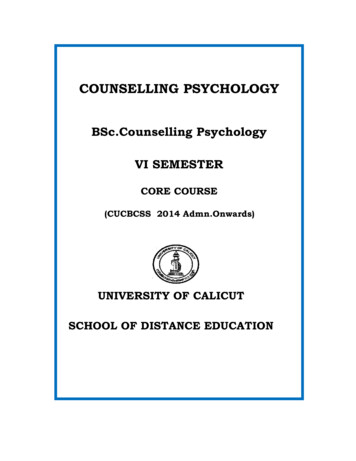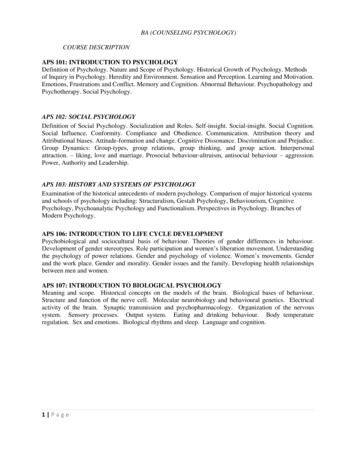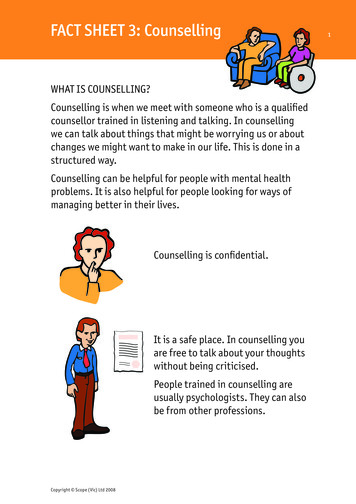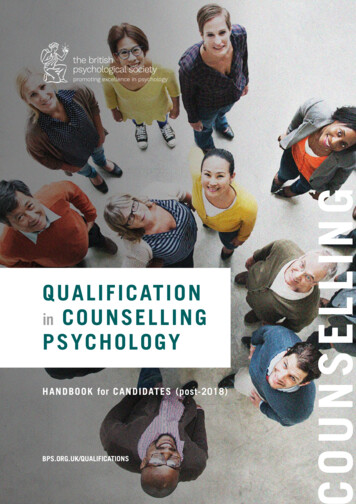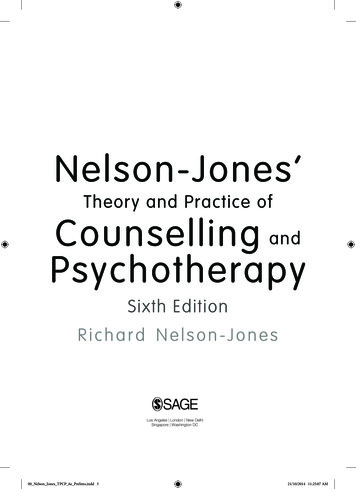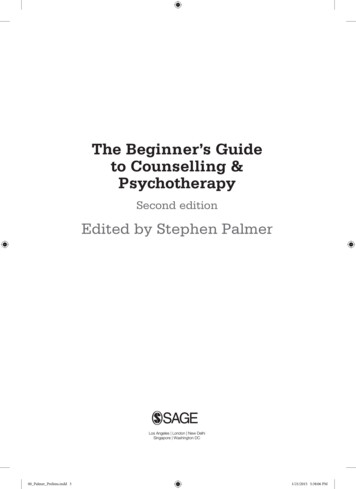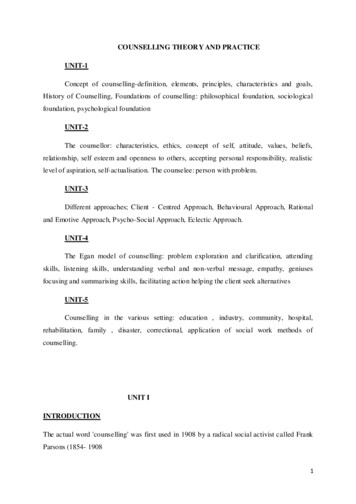
Transcription
COUNSELLING THEORY AND PRACTICEUNIT-1Concept of counselling-definition, elements, principles, characteristics and goals,History of Counselling, Foundations of counselling: philosophical foundation, sociologicalfoundation, psychological foundationUNIT-2The counsellor: characteristics, ethics, concept of self, attitude, values, beliefs,relationship, self esteem and openness to others, accepting personal responsibility, realisticlevel of aspiration, self-actualisation. The counselee: person with problem.UNIT-3Different approaches; Client - Centred Approach, Behavioural Approach, Rationaland Emotive Approach, Psycho-Social Approach, Eclectic Approach.UNIT-4The Egan model of counselling: problem exploration and clarification, attendingskills, listening skills, understanding verbal and non-verbal message, empathy, geniusesfocusing and summarising skills, facilitating action helping the client seek alternativesUNIT-5Counselling in the various setting: education , industry, community, hospital,rehabilitation, family , disaster, correctional, application of social work methods ofcounselling.UNIT IINTRODUCTIONThe actual word 'counselling' was first used in 1908 by a radical social activist called FrankParsons (1854- 19081
Counselling means assistance to the needed people in which assistance. Counselling does notmean ‘Giving Advice’. It can also be thought of as a process in which a person is helped toexplore the situation and find solution or answers for a problem. Counselling is a veryimportant part of everyday life. Many people come to ask us advice on matters concerningthe job that we do or about a personal crisis. The advice we give or the solutions we makethem find are all various aspects of informal counselling.CONCEPT OF COUNSELLING:Concept:1. RELATIONSHIP: counselling is relationship between two people where one personattempts to assist the other to organize himself better to attain a form of happiness byadjusting to the situation.2. BEHAVIORS: the relationship between the counsellor and the client helps to openlydiscuss the problem faced by the client. This helps to increase the skills, courage andself confidence in the client and creates a new behaviour in the client.3. NEW METHODS: are explored to identify solutions for the perceived problem facedby the client. Sometimes, the client may not find a solution, but the thought of beingable to share the problem with another person itself can give a satisfaction to theclient.4. Counselling also helps to develop a set of goals for future behaviour of an individual(client).II.Meaning of counselling:Counselling is a method of guidance of an individual. It helps the client to grow to greatermaturity by allowing the individual to take responsibilities and to make their owndecisions.It can be considered as a relationship between two people where:A. One individual seeks another’s help.B. One person is willing to guide.C. The counsellor is trained to guide and counsel2
D. The client and the counsellor are in a setting where help can be given andreceived.Fields of Counselling (Extra Notes)1. Educational CounsellingA term first coined by Truman Kelley in 1914 (Makinde, 1988), educational counselling is aprocess of rendering services to pupils who need assistance in making decisions aboutimportant aspects of their education, such as the choice of courses and studies, decisionsregarding interests and ability, and choices of college and high school. Educationalcounselling increases a pupil's knowledge of educational opportunities.2. Personal/Social CounsellingPersonal counselling deals with emotional distress and behavioural difficulties, which arisewhen individuals struggle to deal with developmental stages a nd tasks. Any aspect ofdevelopment can be turned into an adjustment problem, and it is inevitable that everyoneencounters, at some time, exceptional difficulty in meeting an ordinary challenge. Forexample: Anxiety over a career decision Lingering anger over an interpersonal conflict Insecurities about getting older Depressive feelings when bored with work Excessive guilt about a serious mistake A lack of assertion and confidence Grief over the loss of a loved one Disillusionment and loneliness after parents' divorce3. Vocational CounsellingVocational counselling is defined as individual contacts with those counselled, in order tofacilitate career development. This definition and category encompasses counsellingsituations such as these: Helping students become aware of the many occupations to consider Interpreting an occupational interest inventory to a student Assisting a teenager to decide what to do after school Helping a student apply to a college or university Role-playing a job interview in preparation for the real thing3
Counselling is very necessary as the lives of people are getting complicated every day.Students and youngsters especially need professional counselling help for them to face themany problems of life. Many of them will be suicidal at one point of their life. Counsellorsare a great help at those times. Counselling can be used to help students and youngsters intheir study habit formation, maintenance of mental health and also to help them achievemaximum efficiency in all their activities.SKILLS NEEDED IN COUNSELLING (Extra Notes)Several skills need to be brought into a one-to-one counselling session. These include:1. Attitudinal skills;2. Listening skills;3. Verbal communication skills; and4. Giving leads.1. Attitudinal skills;There is probably nothing which has a greater impact on the outcome of a counselling sessionthan the helper's attitude. Attitudes can be positive or reactive. Attitudes are included in thisunit on skills because good attitudes can be learned and practised. They include thefollowing:a) Respectb) guidance/congruencec) Unconditional positive regardd) Empathye) self-disclosuref) Confrontationa) RespectIt is one of the most important human attitudes required. It normally begins with respectingone's self, so that others respect you in turn. It is having good intentions and warm regard forstudents. Respect the students and avoid imposing your values on them. Avoid judgment.Many times, respect demands praising the individuality of each student, supporting eachone's search for him/her, and structuring the counselling to the needs, capacities andresources of the individual student. The teacher needs to ensure that the student accepts theproblem and the solution as his/her own.b) Genuineness/Congruence4
Genuineness is at times referred to as congruence. It is the consistency or harmony betweenwhat you say, and what you are, as a teacher. This condition reflects honesty, transparency,and trust. This element is basic to a counselling relationship. Once it is established, opencommunication, warmth and respect for the client gradually develop.c) Unconditional Positive Regard (Warmth)You may have experienced situations where a student approached you with a concer n, andyou blamed the student, or acted as if the student bothered you. These are negative attitudeswhich are ineffective in counselling. Unconditional, positive regard makes students feelwelcomed and valued as individuals. An example to illustrate this warmth is the following:‘Hello, Jane. Can I help you?’Not‘I am sorry, I am very busy. I prefer you to be very brief.’‘Hello. Can I help you? I am sorry I am very busy and prefer that you be brief.’d) EmpathyEmpathy is your ability, as a teacher, to understand what your student’s experience, andcommunicate this kind of feeling. Carl Rogers (1980), defined it as perceiving the internalframe of reference of another person. Gerald Egan (1990), explains it as entering the privateperceptual world of the client, and being sensitive to his/her feelings, whether good or bad.As a teacher, you need to be empathetic. You need to be responsive to both the content andthe feelings expressed by students. This attitude he lps you to assess students' concerns andunderstand them better.e) Self-DisclosureSelf-disclosure helps your student to communicate easily. It is one of the attitudes that helpyour student to reveal something about him/herself. It helps to create mutual trust, and disarmthe student, so that he/she feels free and talks openly. This is equally important for bothparties in the counselling session. It promotes a relationship through increasedcommunication and better understanding of the student. It also helps the student tounderstand him/herself better, and help him/her get rid of the burden of guilt. This is a firststep in behavioural change. Opening with self-disclosure helps the student to talk abouthis/her problems more concretely and realistically, and allows him/her to act accordingly.Disclose only what is necessary.f) Confrontation5
Confrontation is when you use the clients behaviour, or words, to point out inconsistenciesbetween what is said and what is done. When handling a response, co nfrontation, orchallenging attitudes, is a healthy development in counselling.Confrontation helps to bring out a particular feeling but not in a threatening way. In this way,positive action in the client can be initiated.For example, a student may say he/she hates a particular teacher and, in another instance,may say that he/she likes her. This is inconsistent.You could draw the attention of such a student to such inconsistency by saying, ‘You saidthat you did not like the teacher. Now you are saying that you like her. What exactly do youmean?’ Remember to bring this out in a ‘feeling’ and not in a threatening way. You will, inthis way, initiate action in your student.2. Listening skills;Effective listening is more complicated than it seems, since it involves a teacher's own levelof self- awareness, as well as his/her awareness of the spoken and unspoken cues of the otherperson. Furthermore, a teacher needs to be able to respond to the student in such a way thathe/she feels understood. Being a good listener entails receiving and sending appropriatemessages. In counselling this is important, because it means meeting the needs of thestudents.Listening to students is not just a matter of receiving what they say, but also receiving howthey say it. Sometimes how they communicate is much more revealing that what theyactually say, which may be more concealing than revealing. Listening skills are basic to allhuman interaction, whether the purpose is for getting information, conducting in-depthinterviews, or offering informal help. Listening is considered to be the most importantcounselling skill.3. Verbal communication skills;The use of words in counselling is a skill which, like any other skill, requires practice tomaster. Verbal communication takes place first in the literal or content phase. If inappropriatevocabulary is used, rapport and understanding will be hindered. When this happens,miscommunication occurs. Even common words can be misunderstood due to the multiplemeanings they carry. Look up any common English word in an unabridged dictionary, andyou will find several different definitions of this word. So the potential formiscommunication is great. In addition to the literal phase of verbal communication, there isalso the emotional phase. This refers to other attributes involved in vocal interactions, such asvolume, the emotional edge, and other non-verbal cues such as gestures. Picture a student6
saying, ‘I don't care’ while angry, or while indifferently walking away from you, or whileweeping with his head in his hands. Although the words are the same, the message conveyedis vastly different. As helpers, we must be sensitive to both the literal and emotional phases ofverbal communication. In addition to the two general phases of communication that we havejust discussed, there are five more levels of communication. Each of these levels is valuablein different contexts. The five levels of communication are:a) Clichés;b) Facts;c) Beliefs;d) Emotions; ande) Intimacy.a) ClichesThis is a French word which has been adopted by English speakers to mean a trite, well- wornphase. A universal example is the greeting, ‘How are you?’ ‘I'm fine. How are you?’ In someAfrican languages, a formal greeting may take ten minutes and yet nothing new iscommunicated. Everybody is always good or fine, because that is the pattern the greetingtakes. This is communication at the most superficial level, but an important social obligationis met.b) FactsFacts are pieces of information that we pass on to others. They include comments on currentevents like, ‘The morning news mentioned that the President is coming to town tomorrow,’ ormaking conversation on the weather e.g., ‘Those clouds look as if they could bring rain thisafternoon.’ The communication of facts may transmit valuable information from one toanother, but little interaction takes place.c) BeliefsBeliefs include any part of an individual's value system. They may communicate insights andchoices, or facts which are value-laden. The sharing of one's person begins at this level, andthe risk of rejection increases. The sharing of beliefs may include subjects which areconsidered ‘forbidden’ in some cultures, such as sex, politics, or religion.d) EmotionsEmotions include communicating personal feelings. ‘I am thrilled that I was invited to theparty’, or ‘That teacher is rude, he annoys me’. Communication at this level is difficult formost men and women. It requires a great deal of vulnerability to share feelings with someone7
else, and more so when feelings about another are shared. This is the optimum level forcounselling to take place. If the student talk to the teacher at an emotional level and theteacher responds at the level of facts or beliefs, counselling may be derailed. Amiscommunication may occur. Guidance may take place at the facts or beliefs level, buteffective counselling rarely does.e) IntimacyAlthough sometimes used as a euphemism for sexual intercourse, intimacy is more accuratelydefined as the intercourse of the soul. At this level, the self becomes united to another person.This is a level of communication that many individuals never experience. Indeed there issome debate as to whether such a level is even desirable, since the self may be compromised.In counselling, this is an inappropriate level, since it may encourage the dependency of thestudent on the helping teacher and thereby inhibit the student's personal growth.4. Giving LeadsLeads may be defined as statements that counsellors use in communication with the clients.Leads have been classified into categories of techniques, namely:a) Restatement of ContentAttempts to convey understanding by repeating or rephrasing the communication.b) QuestioningSeeks further information ankd asks the person counselled to elaborate a point.c) Reflection of FeelingUnderstanding from the client's point of view and communicating that understanding.d) ReassuranceServes as a reward or reinforcing agent. It is often used to support the client's exploration ofideas and feelings or test different behaviour.e) InterpretationExplains meaning behind the client's statements.DEFINITIONAccording to Pepinsky & Pepinsky “counselling is an interaction which occurs between twoindividuals called counsellor and client which takes place in professional setting and isinitiated to facilitate changes in the behaviour of a client”.8
ELEMENTS OF COUNSELLING:The key elements are:1. Building rapport and understanding2. Gathering data3. Finding out the problem4. Establishing personal involvement5. Giving hope6. Giving homework7. Terminating the counsellingElements are the first thing to be learned in any subject. Rapport Communication Counsellor’s experience Counsellor’s change to positive feelings Structured counselling interviewPRINCIPLES OF COUNSELLING Acceptance Individualization Privacy Confidentiality Accepting limitations RecordingOTHER PRINCIPLES OF COUNSELLINGCounselling is based on n number of principles. These principles are:9
1. Counselling is a process. It is necessary for the counsellor to understand thatcounselling is a process and a slow process. Failure to understand this will result inannoyance and disappointment.2. Counselling is for all. Especially in the school/college situation counselling is meantfor all the students and not only for those who art: facing problems or otherexceptional I students. As we have already discussed in the school situationcounselling is more3.Counselling is based on certain fundamental assumptions.a) Every individual in this world is capable of taking responsibilities for him/her.b) Every individual has a right to choose his/her own path, based on theprinciples of democracy.4. Counsellor does not deprive the right of self-choice but simply facilitates choice.That counsellor should give due respect to the individual and accept him/her as he/sheis.5. Counselling is not advice giving.6. Counselling is not thinking for the client, but thinking with the client. Counsellingis for enabling the client to do judicious thinking.7. Counselling is not proble m- solving. The counsellor simply assists the person to findsolution on his/her own.8. Counselling is not interviewing but conversing with the client in order to helpHim/her developing self understanding,9. The counsellor should determine individual differences and provide for them.10. The counsellor has to prepare the client to open to criticism including selfcriticism.11. The counsellor acts as a facilitator or catalyst only. He creates an atmospherewhich is permissive and non -threatening, through his war111 and acceptingrelationship with the client which helps the client to explore himself/herself andunderstand himself/herself better.CHARACTERISTICS OF COUNSELLING:1. Counselling is a profession dealing with Human Behaviour.2. It has its own standards of education and training which is formal.10
3.It has a systematic body of knowledge that can be imparted.4.It has a set of Technical Skills which may be acquired5. It is a learning oriented process.6.It is a face to face relationship.7.It is a democratic process.8.Successful counselling is based on Goal Setting and Attainment.9.It is based on Mutual and Professional Relationship.10. It takes place in a professional setting.GOALS OF COUNSELLINGWhat is a goal?Goal is something that has to be achieved.Mainly there are three types of goals,1. Immediate goal2. Long term goal3. Ultimate Goal1.Immediate goalImmediate goal means when a person comes to a counsellor our immediate goal is to giverelief to the client; it can be given through supportive therapy or through the creation ofrapport.2.Long term goalThis is to make a client to a fully functioning person. These two goals can be achievedthrough a process or mediate goal. Precipitating factors and pre disposing factors are11
Important when achieving goals. This process is achieved through self exploration that leadsto behavioural change.3.Ultimate goalThis is to make the client a fully functioning and to lead a good family life, to lead a creativelife.Counselling has six major goals and they are: Achieving positive mental health Resolution of problem Improving personal effectiveness Modification of behaviour Helping to change Decision makingMany consider counselling a panacea for all ills, which is not true. Individuals have wideranging ant1 many a time unrealistic expectations regarding counselling. This in turn led todisappointment. The reason for this state of affairs is lack 0f proper understanding as to whatexactly are the goals of counselling.Some of the major goals of counselling generally accepted by counsellor are given below:1. Achievement of positive mental health CounsellingAn individual is said to have positive mental health when he is able to relate meaningfullywith others and lead a fulfilling life. He is able to love and be loved. One goal of counsellingis to help the individual to attain this state.2. Proble m resolutionAnother goal of counselling is to help the individual to come out of a difficult situation orproblem. It must be remembered that the individual is only assisted and he himself findsolution for the problems.3. Counselling for decision-makingAbility to make right and timely decisions is crucial for success in life. One major goal ofcounselling is to make individual capable of making independent decisions. Counsellor may12
assist the individual by providing necessary informing or clarifying the counselee's goals, etc.but the decision should be taken by the counselee herself/herself.4. Improving personal effectivenessAs effective person is one who is able to control impulses, think in creative ways and has thecompetence to recognize, define and solve problems. It can be seen that these different goalsare not exclusive. These are all interdependent and overlapping.5. Help changeFor development, change is always necessary. Counselling helps individual to make changesin their attitude, perceptions or personality.6. Behaviour modificationAnother aim of' counselling is to help in modifying behaviour. Removal of undesirablebehaviour or self-defecting behaviour and learning desirable behaviour is considerednecessary for attaining effectiveness and good adjustment. The behaviourally orientedcounsellors are the chief proponents of this view.HISTORY OF COUNSELLING Early stage/ pre-historic counselling period: Early counsellors were priest, medicine man- shaman, physicians and philosophers. Ancient Guru’s and Religious Leaders:Budha, Socrates, Mausis are considered as ancient Guru’s and religious leaders. Theyassisted in spiritual, religious aspects of their followers. The first founders of counselling:The important founder during this period was Hippocrates, a Greek Philosopher whodiscovers Homeostasis (physiological balance in the body) and Prognosis (how a diseasedevelops). He was the person who introduced systematic counselling intervention. And healso takes case history and builds a trust in patient. Sigmund Freud and Joseph Breuer wasthe another important founders who founds that Hypnosis as the study of unconscious mind.Sigmund Freud brought a formal method of psychoanalysis (id, ego, super-ego, dreamanalysis etc.). Influence from psychologist (19th century)13
During the period of 19th Century far-reaching innovations in the field of psychology weremade. This period saw the founding of the first psychological laboratory at Leipzig byWilhelm Wundt in 1879. Stanley Hall started the first psychological laboratory in the USA in1883. In 1895, George Merrill established the first systematic vocational programme in SanFrancisco. Lightner Witmer heralded the beginning of the counselling movement by foundingthe first psychological clinic in 1896. J. B Miner established and directed the free clinic in mental development at theUniversity of Minnesota in 1909. However, it was Jesse.B.Davis who first used the term “Counselling”. Significant Events in 20th Century (1900-1930)During the first few years of the twentieth century several significant events took place.They were: The first convention of the International Congress of Psychoanalysis was held atSalzberg. Stanley Hall invited Carl Gustav Jung to lecture at the Clark University. Clifford beers launched the ‘Mental Hygiene Movement’ with his epoch-makingbook, ‘The mind that found itself’. The use of psychological principles was advocated in pastoral counselling byRev.Elwood Worcester. The vocational Guidance movement was started on a modest scale by SamuelFrank parsons and Eli Weaver in Boston and Brooklyn respectively. Guidance was introduced by Wheatly and Boyden and Jessie Davis. Binnet-Simon tests of intelligence were adapted to American conditions aboutthis time.14
The progressive Education Movement was initiated by John Dewey with hisepoch- making book, ‘How we Think’. The school of social work started by Mrs. Adolf Meyer E.L Thorndike and Robert Yerkes helped develop the Army Alpha and Army Betatests for screening the defence personnel. James Burt Miner developed the first ever known questionnaire in 1908. R.S. Woodworth and F.L Wells association tests and psychometric inventory in1911, which was developed as a screening device for the army recruits. Development of tools and techniques(1930-1940)From the end of World War I to the outbreak of World War II, saw the publication ofbooks and important psychological tests, such as Harry Kitson’s ‘psychology ofVocational Adjustment’ (1925), Clark. L. Hull’s Aptitude Testing (1927) and E.K StrongJr’s Strong Vocational Interest Blank (SVIB-1943). National vocational Guidance Association (NVGA), founded in 1913, formed theAmerican Council of Guidance and Personnel Association in 1934. Robert Hoppock, a former secretary of NVGA published his book Jobsatisfaction in 1935. L.L. Thurstone’s Tests of Primary Mental Abilities in 1938. Donald Paterson and E.G. Williamson during 1930-1940 at Minnesota,concerned with the objective assessment of the individual’s abilities. Counselling Era(second World War and after)Counselling which finally established as a science in its own right was achievedthrough Carl Roger’s book, Counselling and Psychotherapy (1942). In 1944, the Army separation and Classification and counselling Program wasinitiated and the United States Employment Services (USES) published theGeneral Aptitude Test Battery (GATB) in 1945. First journal of Counselling Psychology was published in 1954.15
Era of therapeutic counselling:The domain of mental health was given importance. Individual freedom, liberty,values of life all taken in to consideration. Counselling settings were diversified.Community mental health care was started and counselling involves four mainaspects: Self understanding Self direction Self realization Self actualization Licensing, regulation and research were given importance 1973 in US and in 1992 in India standardized counselling practice and diploma incounselling was started. But India does not have Licensing authority. Research was done on psycho social care, stress, trauma etc. And the y say thatcounselling is necessary in those areas. In 2004 NIMHANS started Disaster management programme with the Govt. OfIndia.FOUNDATIONS OF COUNSELLING: There are main 3 foundations based on whichCounselling is done: Philosophical Foundation Sociological Foundation Psychological Foundation.Foundation of counselling includes many disciplines such as Philosophy, Sociology, andPsychology etc. Psychiatry, family studies and social work are the other disciplines that pavethe foundations to counselling.1.Philosophical foundation:The philosophy deals with human values and the counselling gives importance tohuman value. The philosophy tells about the sense of purpose in life, while16
counselling helps to attain or make him understand about the purpose of life.Philosophy tells about values, sensible, being considerable, being right and wrongetc. On the other hand, all these are practiced in counselling. Counselling beliefs inm,an’s faith, his abilities and this is what philosophy teach usSmith’s Philosophical Foundation of Counselling:o Faith in humanityo Concern for other persono Belief in potentiality and inner strength of mano Self responsibilityo Freedom to choose sovergnityo Cherishing values of life.2. Sociological foundationIt studies about how a man functions in social settings. In counselling, we deal withindividual and their problem. Unless, we know about the society, we cannot solve theproblem. Thus, the counsellor should know the culture and values of the society in which heis practicing counselling. Values, beliefs, systems acquired from the society can be useful inproviding counselling.Counselling respects values, beliefs, systems of the client. Sociology teaches about theuniqueness about all these aspects. It also teaches about the various aspects of life.Each culture and system is different from the other; hence what is right in one culture may bewrong in another culture. Hence counselling must be based on the values of the client and notof the counsellor.Eg: Children sleeping with parents is accepted in India. But in the west it is not accepted.3. Psychological foundationCounselling deals with human behaviour and psychology is the scientific study of humanbehaviour. Counselling has roots in psychoanalysis ( ego stages, free association, dreamanalysis). Functionalism in 1990’s is an important aspect in counselling.Psychology also talks about the primary interest of the client. It deals with Motivation,Personality, Development stages, Memory, Nature and Nurture, defence Mechanism etc. It17
also talks about code of ethics which is applied in counselling. Concept of self and goaldirected behaviour is very important in counselling.UNIT 2PROBLEM CYCLEPROBLEM SOLVING CYCLE18
THE COUNSELLORGeneral Characteristics of counsellorThe importance of the counsellor attitude to counselling outcomes cannot be over emphasized.in order to identify the counsellor characteristics which are of concern, investigatorsemployed four approaches. SPECULATION - The question as to what the characteristics of an effectivecounsellor are too led to speculation. The national vocational guidance association(1949) listed such characteristics as interest in people, patience, sensitiveness,emotional stability and objectivity as being important for good counselling. IDENTIFYING THE EFFECTIVE AND INEFFECTIVE GROUPS : Steffre King(1962) found effective and ineffective counselor samples on the four dimensionsstudied namely academic promise, interest and promise, personality characteristicsand self concept. The effective group obtained high score on academic aptitude andperformance and scored higher on social welfare. Hypothesized characteristics : the approach is used to find out whether certaincharacteristics that have been hypothesized as necessary for counseling present andfunctioning. Bandura(1956)tes
COUNSELLING THEORY AND PRACTICE UNIT-1 Concept of counselling-definition, elements, principles, characteristics and goals, . The use of words in counselling is a skill which, like any other skill, requires practice to master. Verbal communication takes place first in the literal or content phase. If inappropriate

